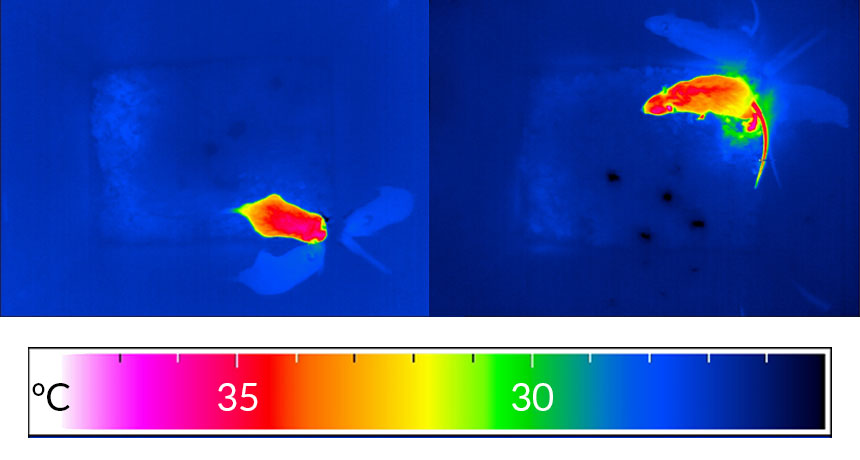Cool nerve cells help mice beat heat
Scientists identify sensors in part of hypothalamus key to regulating body temperature

HEAT DUMP In an effort to lower its body temperature, a mouse’s tail heats up (right) half an hour after a certain group of nerve cells are turned on (before, shown left).
Hong Wang and J. Siemens
- More than 2 years ago
Scientists have identified the “refrigerator” nerve cells that hum along in the brains of mice and keep the body cool. These cells kick on to drastically cool mice’s bodies and may prevent high fevers, scientists report online August 25 in Science.
The results “are totally new and very important,” says physiologist Andrej Romanovsky of the Barrow Neurological Institute in Phoenix. “The implications are far-reaching.” By illuminating how bodies stay at the right temperature, the discovery may offer insights into the relationship between body temperature and metabolism.
Scientists had good reasons to think that nerve cells controlling body temperature are tucked into the hypothalamus, a small patch of neural tissue in the middle of the brain. Temperature fluctuations in a part of the hypothalamus called the preoptic area prompt the body to get back to baseline by conserving or throwing off heat. But the actual identify of the heat sensors remained mysterious. The new study reveals the cells to be those that possess a protein called TRPM2.
“Overall, this is a major discovery in the field of thermoregulation,” says Shaun Morrison of Oregon Health & Science University in Portland.
Jan Siemens, a neurobiologist at the University of Heidelberg in Germany, and colleagues tested an array of molecules called TRP channels, proteins that sit on cell membranes and help sense a variety of stimuli, including painful tear gas and cool menthol. In tests of nerve cells in lab dishes, one candidate, the protein TRPM2, seemed to respond to heat.
The researchers gave mice artificial fevers by injecting “heat up” molecules into the hypothalamus. Mice that lacked TRPM2 grew about 1 degree Celsius warmer than mice with the protein, results that suggest that TRPM2 helps counter high temperatures. “We like to think of it as an emergency brake” that prevents a fever from getting too hot, Siemens says.
Romanovsky cautions that the fever results are not easy to interpret. In some experiments, mice without TRPM2 didn’t run hotter fevers than mice with the protein. More experiments are needed to clarify how these nerve cells affect fever, he says.
Siemens and colleagues then used a genetic trick to take more direct control of preoptic-area nerve cells that have TRPM2. When these cells were prevented from firing off signals, the mice heated up slightly. And when these cells were prompted to fire off lots of signals, the mice grew downright frigid. A mouse’s normal body temperature hovers around 37°C (98.6°Fahrenheit). After a burst of activity from TRPM2 neurons, mice’s temperatures dropped by about 10 degrees C and stayed cool for about 12 hours, the team found. “That was really a ‘wow’ experience when we saw this,” Siemens says.
Story continues after video
Activating a specialized group of nerve cells in the brain’s hypothalamus caused a mouse to cool down. Minutes after a treatment that turned these cells on, the mouse’s tail and paws began to heat up as blood vessels grew wider, a process called vasodilation, and warm blood traveled to the surface of the body. Heat transferred to the floor of the mouse’s cage; eventually, the mouse’s body temperature dropped all over.Hong Wang and J. Siemens |
The cold mice grew less active, but didn’t seem to suffer any ill effects. It’s not clear how similar this chilly state is to torpor, a hibernation-like state that mice enter when the temperature is cold or food is scarce.
When these nerve cells sent their cool-down signals, mice started dumping body heat by shunting warm blood to the surface of their bodies, warming up the paws and tails — body parts from which heat easily escapes. Infrared cameras revealed hot tails soon after the nerve cells were activated. The mice’s sleeping areas also heated up as warmth transferred from bodies to beds, the cameras revealed. “They were actually warming up their surroundings,” Siemens says.
More work is needed to say whether similar cells help cool people, and scientists don’t have good drugs that affect TPRM2 specifically. Yet the results might one day lead to ways to induce hypothermia from inside the body. Doctors sometimes use ice packs and cooling blankets to chill people after cardiac arrest. But an internal cooldown might be more effective.
What’s more, the chilly mice may also offer scientists ways to study how body temperature and metabolism are connected. The results could have important implications for obesity and longevity, both of which are related to metabolism, Morrison says.






